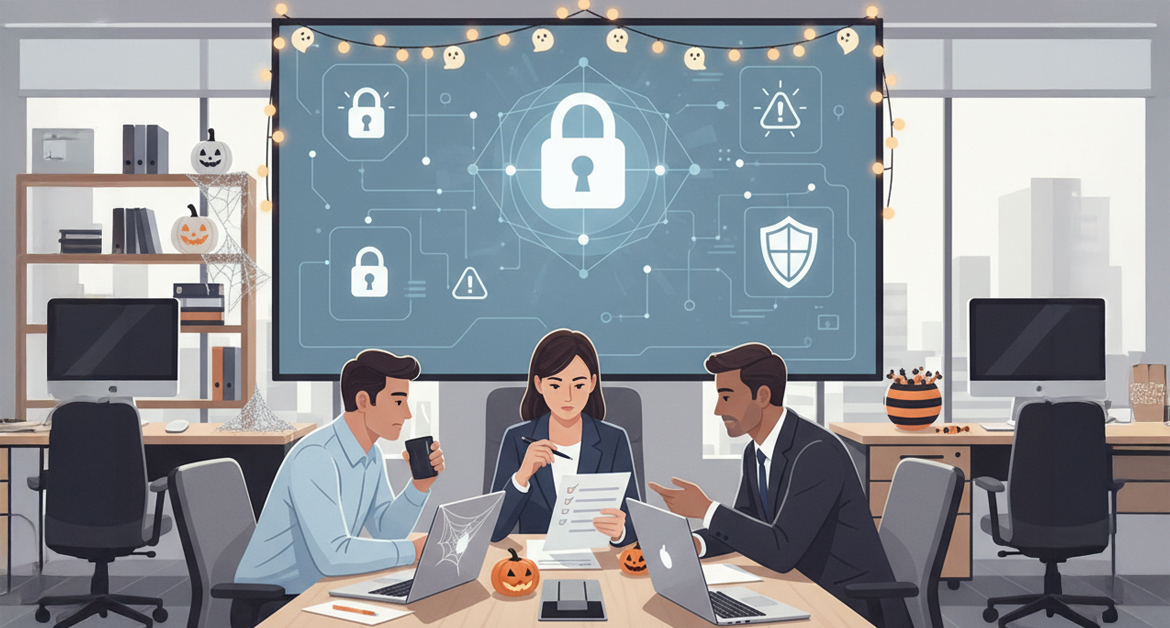Imagine waking up on Halloween morning not just to trick-or-treaters knocking at your door, but to an alert that your company’s files have been encrypted overnight. Instead of costumes and candy, you face ransomware demands and potential business paralysis. That scenario feels scarier than any haunted house, yet for many small and midsized businesses, it’s a real possibility. October is Cybersecurity Awareness Month, and it’s the perfect reminder to revisit the fundamentals that keep your organization safe.
The Seasonal Reminder Business Leaders Need
Cybersecurity Awareness Month exists for a reason: threats don’t take holidays off. In fact, attacks targeting SMBs often spike during high-activity periods like year-end, when employees are distracted. The timing in October is especially fitting given how closely fear is tied to both Halloween traditions and the reality of cyberattacks. Leaders can use this month as a structured checkpoint to review whether their teams, technology, and policies can withstand the most common forms of attack.
The Basics Deserve More Attention Than You Think
Many breaches don’t stem from sophisticated zero-day exploits. They start with weak passwords, out-of-date systems, or an employee clicking on a carefully crafted phishing email. Here are foundational elements every SMB should double-check:
- Strong Authentication: Require multi-factor authentication everywhere possible, not just for remote staff.
- Timely Updates: Patch software, stop delaying operating system upgrades, and audit applications that may no longer be supported.
- Backups: Test them, don’t just assume they work. Ransomware attacks lose power when reliable backups exist.
- User Training: Make cybersecurity awareness part of onboarding and ongoing education. Employees remain the most common entry point.
These fundamentals may seem tedious compared to advanced threats, but they are where most damage starts.
Why AI and Data Trends Should Be On Your Radar
According to Quantive’s 2025 report, 77% of businesses are already using or exploring artificial intelligence. For SMB leaders, this means both opportunity and risk. AI-enabled tools can rapidly flag anomalies and detect suspicious activity, but cybercriminals are equally aggressive in using AI to craft more convincing phishing attempts and automate attacks. Business leaders should view this dual reality as a call to adopt AI-driven security solutions while also preparing staff for smarter attacks.
Meanwhile, the global data analytics market has grown from USD 50.04 billion in 2024 to USD 64.75 billion in 2025, as reported by Folio3. This growth underscores a deeper truth: businesses that don’t use analytics are at a disadvantage not only in decision-making but also in security monitoring. Data-driven insights can reveal patterns in login activity, spot latent vulnerabilities, and highlight user behaviors that need new safeguards. In an environment where data is both currency and target, it is no longer optional to monitor it closely.
The SMB Workforce Factor
The health of a workforce plays a surprising role in cybersecurity readiness. Deloitte Insights noted in November 2024 that manufacturing employment trends stabilized after years of fluctuation. That stability matters because turnover often leads to gaps in security training. When fewer new hires stream through the door, organizations have an opportunity to mature their security culture instead of constantly retraining new staff. This is especially relevant to SMBs, where lean teams mean each employee represents both a critical asset and a potential vulnerability.
Practical Steps for Cybersecurity Awareness Month
Business leaders don’t need to overhaul an entire IT infrastructure this month, but they should complete specific, measurable actions:
- Audit Access: Review who still has access to sensitive systems. Remove permissions for inactive users.
- Review Your Incident Response Plan: If ransomware hit tomorrow, do employees know who to call and what to do first?
- Validate Vendor Security: Confirm third-party suppliers with access to your systems have appropriate protections.
- Refresh Training: Even a short session on spotting social engineering emails pays dividends.
- Engage in Simulation: Test your team with a phishing drill or tabletop exercise.
These steps prevent small cracks from turning into catastrophic breaches. They also demonstrate to employees, customers, and partners that your company takes security seriously.
A Halloween Lesson Every Business Can Learn From
Just as no homeowner would leave the front door unlocked on Halloween night, no business should leave gaps in its digital defenses. For SMB leaders, Cybersecurity Awareness Month is less about doom and gloom and more about creating a reliable annual check-in. Think of October like an annual fire drill: a chance to test your controls, identify weak spots, and prepare your business for whatever spooks might appear in your inbox.
The Final Word for Leaders
The scariest part of a crypto attack isn’t the ransom note itself, but the realization that it could have been avoided with small but disciplined actions. Cybersecurity Awareness Month is the chance for business leaders to remind themselves and their teams that security starts with fundamentals. Are your safeguards in place, tested, and ready? If not, the horror story is waiting just around the corner.






